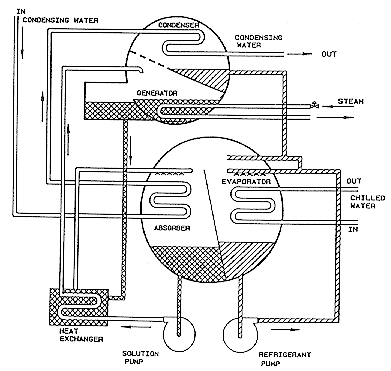absorption chiller

Typical absorption chiller components.
An absorption chiller is a type of air cooling device that uses absorption cooling to cool interior spaces.
The key feature of absorption cooling equipment is that it produces cooling by using heat energy as an input, rather than by using mechanical energy. For this reason, absorption chillers were once common in facilities that had large boiler plants with excess capacity during the cooling season. Unfortunately, absorption cooling is inefficient, and absorption chillers appeared destined for extinction. However, new circumstances are giving absorption chillers a revival.
The components of an absorption chiller must be integrated much more closely than the components of a compression cooling system. As a result, all absorption chillers are contained within a single compact package. For the same reason, absorption chillers have few variations. In all large absorption systems, cooling is distributed by chilled water. Similarly, all condensers are cooled by water, usually from a cooling tower.
In large absorption machines, the actual refrigerant is water at very low pressure. An absorber, usually the salt lithium bromide, is used to move water vapor through the system. Crystallization of the salt is a major operating problem that the design of an absorption chiller seeks to avoid.
The main differences between models are in the heat source and in the number of stages. Originally, the energy source for absorption chillers was steam or high-temperature hot water. Presently, direct firing using an integral boiler is gaining popularity because of its greater efficiency. Older absorption machines were single-stage machines. However, they are being supplanted by two-stage machines, which provide substantially higher efficiency. Virtually all direct-fired absorption machines are two-stage.
